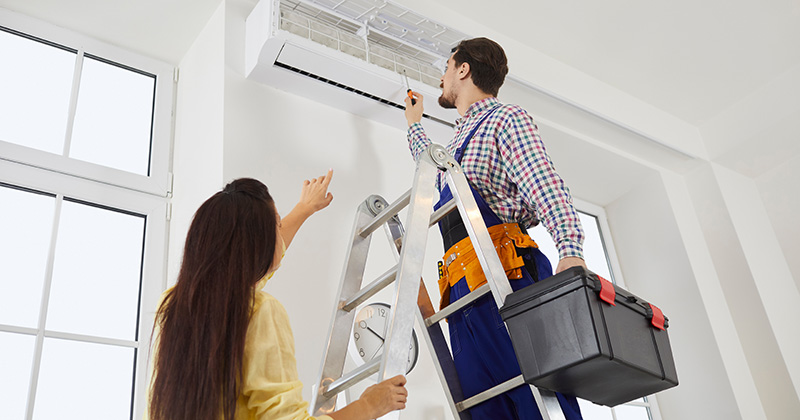
Running an HVAC business means providing heating, ventilation, and air conditioning services. Sometimes, that means working with homeowners. Other times, it means serving commercial clients.
But it’s not just about fixing systems and keeping things cool or warm. Building strong relationships with your customers is key. So, too, is ensuring their ongoing satisfaction.
In this guide, we will explore effective strategies that will help you keep your customers happy, loyal, and coming back for more. We will define customer retention. We’ll show you how to calculate customer lifetime value. Then, we’ll dive into the practical steps to develop a winning HVAC customer retention strategy.
Finally, we’ll explore high-impact retention strategies that will keep your customers smiling.
Are you ready to unlock the secrets to success? Let’s dive in.
What Is Customer Retention, and Why Does It Matter?

Customer retention describes the ability of a business to keep its existing customers over a certain period of time. In simpler words, it means how well a company can make its customers stick around.
Why is HVAC customer retention so important? Here are a few reasons to consider.
Firstly, acquiring new customers can be expensive. It involves spending money on advertising and marketing. On the other hand, retaining existing customers costs much less. So, by focusing on customer retention, an HVAC business can save money and resources.
FROM ONE OF OUR PARTNERS: What Is Customer Acquisition Cost? (And How Can HVAC Companies Lower Theirs?)
Here’s an interesting fact: Acquiring a new customer can be up to 5 times more expensive than keeping an existing one. Just think about it. Wouldn’t you want to save the cash and invest it in growing your business instead?
Secondly, loyal customers tend to spend more money on your HVAC services. They trust your business. They are more likely to come to you when they need repairs, maintenance, or upgrades. They become repeat customers, and their lifetime value increases.
What Is the Lifetime Value of an HVAC Customer?
The lifetime value of an HVAC customer is the total amount of money a customer is expected to spend on your services throughout their entire relationship with your business.
Why is this so critical, specifically for HVAC companies?
In the HVAC industry, there are many opportunities for repeat business. Customers often require regular maintenance. They may also need repairs and replacements for their heating and cooling systems. You can increase their lifetime value by providing excellent service and building a strong relationship with your customers.
Think about it this way: When you have a loyal customer who trusts your business, they are more likely to sign up for service contracts. This provides a steady stream of income for your business.
Additionally, when they have a positive experience with your HVAC services, they are more likely to recommend your business to their friends, family, and colleagues. They become brand advocates. And this brings in new customers.
How to Calculate Customer Lifetime Value
Now, let’s talk about how to calculate customer lifetime value (CLV). Although it involves some math, it’s not as complicated as it may seem.
Here’s a simple formula to calculate CLV:
CLV = (Average Purchase Value) x (Average Purchase Frequency) x (Average Customer Lifespan)
Let’s break it down:
- Average Purchase Value: This refers to the average amount of money a customer spends each time they use your HVAC services. To calculate this, add up the total revenue generated from HVAC services. Then, divide it by the number of customers.
Average Purchase Value = Total Revenue from HVAC Services / Number of Customers
- Average Purchase Frequency: This represents how often a customer uses your HVAC services within a specific time period. For example, if a customer typically calls for service once a year, the average purchase frequency would be 1.
- Average Customer Lifespan: This indicates the average number of years a customer stays with your HVAC business. It can be based on historical data or industry averages.
Once you have these three values, multiply them together to calculate the customer lifetime value. The resulting number represents the estimated total value a customer brings to your business throughout their entire relationship with you.
Let’s see the CLV formula in action with an example:
Imagine you run an HVAC business and want to calculate the CLV for your customer base. Here are the values you’ll need:
- Average Purchase Value: Let’s say your total revenue from HVAC services for the year is $100,000. You have 200 customers. To calculate the average purchase value, divide the total revenue by the number of customers.
Average Purchase Value = $100,000 / 200 = $500
So, on average, each customer spends $500 when they use your HVAC services.
- Average Purchase Frequency: Suppose your customers typically require HVAC services twice a year.
Average Purchase Frequency = 2
This means that, on average, a customer uses your HVAC services twice within a year.
- Average Customer Lifespan: Based on your business records and analysis, you find that the average number of years a customer stays with your HVAC business is 5.
Average Customer Lifespan = 5
Now, let’s put the values into the CLV formula:
CLV = (Average Purchase Value) x (Average Purchase Frequency) x (Average Customer Lifespan)
CLV = $500 x 2 x 5
CLV = $5,000
In this example, the CLV is $5,000. This means that, on average, each customer brings $5,000 worth of revenue to your business throughout their entire relationship with you.
Tracking and evaluating CLV can provide valuable insights into the health of your business. It can help you make informed decisions.
Consider using customer relationship management (CRM) software or other tools to keep track of customer interactions, purchase history, and service calls. By analyzing this data, you can identify trends. This allows you to improve customer service and tailor your marketing efforts to retain and satisfy your HVAC customers.
FROM ONE OF OUR PARTNERS: HVAC Marketing Strategies: How to Get More Leads
Developing Your HVAC Customer Retention Strategy

Developing a custom customer retention strategy for your HVAC business is essential. With the right approach, it can secure long-term business success.
Follow these step-by-step guidelines to create an effective plan.
Step 1: Assess Your Current Situation
Evaluate your existing customer retention efforts. Identify areas for improvement. Analyze data on customer satisfaction, customer lifetime value, and customer feedback. This assessment will provide a foundation for developing targeted strategies.
Take action:
- Review customer feedback from past service calls. Note common pain points or areas for improvement.
- Conduct a survey or interview a sample of your existing customers. Gather insights into their satisfaction levels and expectations.
- Analyze customer lifetime value data. Identify trends and patterns that can inform your retention strategy.
Step 2: Understand Your Customers
Get to know your HVAC customers on a deeper level. Understand their needs, preferences, and pain points. Conduct surveys, interviews, or focus groups to gather valuable insights. This understanding will help you tailor your services and customer experiences.
Take action:
- Create a survey or questionnaire.
- Conduct focus groups or one-on-one interviews. Gain deeper insights into their motivations and challenges.
- Research CRM software. Find one to help you track customer interactions and collect data on their behavior and preferences.
Step 3: Define Your Unique Value Proposition
Identify what sets your HVAC business apart from competitors. Determine your unique value proposition. Make sure it highlights the benefits and advantages that customers receive by choosing your services. This will inform your messaging and give you a competitive edge.
Take action:
- Conduct market research. Assess your competitors.
- Analyze customer testimonials and feedback. This will help you determine the key benefits and advantages they value in your services.
- Develop a clear and compelling UVP that showcases these unique qualities and differentiates your business from competitors. Brainstorm ways to communicate your UVP through branding, marketing collateral, and content.
Step 4: Enhance Customer Service
Consider ways to improve your customer service processes. How can you ensure a seamless and hassle-free experience for your HVAC customers? You might build processes that ensure team members:
- Respond promptly to service calls
- Address customer concerns with empathy
- Provide transparent communication throughout the service process
Exceptional customer service will leave a lasting impression and increase customer satisfaction.
Take action:
- Implement a system to track service calls and response times.
- Train your team members on effective communication skills. Focus on addressing customer concerns with care and understanding.
- Develop a transparent communication protocol. This should keep customers informed about the progress of their service requests.
Step 5: Shape Effective Customer Loyalty Programs
Design customer loyalty programs to reward and incentivize your loyal HVAC customers. According to a survey, free loyalty programs increase the likelihood of repeat purchases by 30 percent.
Offer exclusive discounts, priority service, or special perks. This shows appreciation for their continued support. These programs foster a sense of loyalty. They also encourage repeat business.
Take action:
- Design a tiered loyalty program. It should offer increasing benefits based on the duration and frequency of customer engagement.
- Consider the possibility of exclusive discounts or priority service to loyal customers. Does your current price point and cash flow allow for this approach?
- Write content that communicates the benefits of the loyalty program. This content can be distributed through email newsletters, social media posts, and targeted promotions.
Step 6: Stay Connected and Engaged
Maintain regular communication with your HVAC customers to strengthen relationships. Ensure your strategy includes the following:
- Personalized newsletters
- Seasonal maintenance reminders
- Helpful tips related to HVAC systems
Use various channels such as email, social media, or direct mail to stay connected. This consistent engagement will keep your business top of mind.
Take action:
- Find an email newsletter platform that meets your needs and budgetary limitations. Create an account and set up your mailing list.
- Create social media accounts on your customers’ preferred platforms. Optimize your profiles.
- Consider hosting customer appreciation events or webinars to foster a sense of community and strengthen customer relationships.
6 Customer Retention Strategies to Keep Your Customers Coming Back

As an HVAC business owner, you understand the vital role customer retention plays. It’s crucial to your success. It also impacts two essential metrics: CLV and return on investment.
ROI measures the profitability of your business endeavors. It represents the ratio between the gains or benefits (such as revenue) and the costs incurred. In the context of HVAC customer retention, boosting ROI means maximizing the returns you receive from your efforts. This includes retaining customers while minimizing the associated costs.
Improving customer retention impacts your business’s ROI. By implementing effective strategies, you reduce the need for costly customer acquisition efforts.
What’s more, loyal customers who remain satisfied with your HVAC services are more likely to refer your business. These referrals act as a form of organic marketing. They generate new customer acquisitions without incurring substantial expenses.
Implementing effective strategies to retain customers can lift your ROI. Plus, it can strengthen your business’s financial outlook. Here’s how that might look in practice.
Strategy 1: Prioritize Customer Satisfaction
One of the most effective ways to retain HVAC customers is by prioritizing their satisfaction—80% of organizations expect to compete primarily on customer experience.
Happy customers are more likely to become loyal customers. On the other hand, more than half of customers will switch to a competitor after one negative experience.
To achieve this:
- Focus on delivering exceptional customer service at every touchpoint.
- Train your staff to be friendly, knowledgeable, and responsive.
- Make sure your technicians arrive on time. Ensure they communicate clearly, and address any concerns promptly.
Remember, a positive customer experience trumps customer acquisition in the long run.
How this strategy supercharges your ROI:
Prioritizing customer satisfaction is crucial. It helps you retain HVAC customers and boosts your ROI. Satisfied customers refer your services to others. Like a domino effect, this leads to new customer acquisition through word of mouth.
Additionally, happy customers are less likely to switch to a competitor. This reduces the need for costly marketing and customer acquisition campaigns. You can cultivate a loyal customer base that generates a steady revenue stream.
Strategy 2: Enhance the Customer Experience
To retain customers, you must go beyond a satisfactory service. You must create an outstanding customer experience.
Look for opportunities to exceed expectations. Always strive to provide added value. Offer personalized recommendations based on customers’ specific needs.
For example, provide tips for efficient energy usage. Or share ways to improve indoor air quality. Consider implementing a customer loyalty program to reward repeat business.
You can significantly increase customer retention by making your customers feel valued and appreciated.
How this strategy supercharges your ROI:
Enhancing the customer experience goes hand in hand with boosting customer retention. It also maximizes your ROI.
When customers have a positive experience with your HVAC business, they are more likely to become repeat customers. And, they will recommend your services to others. This means free advertising for your business.
By providing added value and personalized recommendations, you strengthen customer loyalty. You also increase the likelihood of upselling additional products or services. This enhances your average customer lifetime value. It also contributes to a higher ROI for your business.
Strategy 3: Build Strong Customer Relationships
Building strong relationships with your HVAC customers is crucial for long-term retention. Take the time to understand their needs and preferences. Maintain a database of customer information. This might include their preferred communication channels and service history. Use this to personalize interactions.
Follow up with your customers. Check on their satisfaction and offer any necessary maintenance or upgrades. By fostering trust and connection, you can create loyal customers.
How this strategy supercharges your ROI:
Building strong relationships with your HVAC customers is a powerful driver of ROI. Loyal customers tend to have a higher customer lifetime value. Why? Because they continue to rely on your services over an extended period.
By understanding their needs and preferences, you can tailor your offerings and communication. You can better meet their expectations. This leads to increased customer retention and higher revenue.
Additionally, loyal customers are more likely to provide positive reviews and recommendations. This attracts new customers and further boosts your ROI.
Strategy 4: Leverage Customer Feedback
Customer feedback is valuable for improving your HVAC business and retaining customers. Encourage your customers to provide feedback. Share surveys, promote online reviews, or use direct communication. Pay attention to their comments, suggestions, and concerns.
Use this feedback to identify areas for improvement. Be sure to address any issues promptly. Valuing and acting upon customer opinions can increase customer loyalty to your business.
How this strategy supercharges your ROI:
Leveraging customer feedback is a strategic approach to improving your HVAC business.
You can enhance your service offerings by actively seeking feedback. Addressing customer concerns is also key. You can optimize operational processes, leading to improved customer satisfaction. Satisfied customers are more likely to remain loyal to your business.
This results in increased customer retention and recurring revenue.
Moreover, improving based on customer feedback demonstrates your commitment to exceptional service. This can positively impact your reputation and attract new customers.
Strategy 5: Offer Hassle-Free Service Calls
Convenience plays a significant role in customer retention. Make it as easy as possible for your customers to schedule service calls. Also, focus on providing help when needed.
Adopt an online booking system. It should allow customers to schedule appointments effortlessly. Provide clear instructions for troubleshooting common HVAC issues over the phone. Or, offer help through your website.
RELATED ARTICLE: Should HVAC Service Providers Offer Prices Online?
Hassle-free service calls show that you value your customers’ time. It demonstrates your willingness to provide a seamless experience.
How this strategy supercharges your ROI:
Offering hassle-free service calls can significantly impact your ROI. It streamlines your workflows and enhances customer satisfaction.
Implementing an online booking system makes your customers’ lives easy. Providing clear instructions for troubleshooting minimizes scheduling errors. It also reduces time spent on administrative tasks. This efficiency allows you to serve more customers and increase your revenue potential.
Plus, customers will likely remain loyal to your business when they have a seamless and convenient service experience. This feeds into higher customer retention rates and a boosted ROI.
Strategy 6: Provide Ongoing Education and Support
You’re an expert at what you do. Educating your customers can help foster long-term loyalty.
Offer resources such as blog articles, informative videos, or newsletters. These might contain tips and tricks for optimizing HVAC performance. Provide guidance on seasonal maintenance tasks that customers can perform themselves.
How this strategy supercharges your ROI:
Providing ongoing education and support to your HVAC customers directly impacts your ROI.
By offering valuable resources and guidance on maintenance and energy efficiency, you empower your customers. They can take better care of their HVAC systems. This can lead to fewer breakdowns and service calls. It reduces your operational costs and increases your profitability.
Additionally, when customers see you as a knowledgeable and reliable source of information, they are more likely to trust your recommendations. They will invest in higher-value services, further boosting your ROI.
FROM ONE OF OUR PARTNERS: Criterion for Growth for Commercial HVAC Service Contractors
Take the First Steps Today

Remember, every interaction with a customer is an opportunity to make a positive impact and leave a lasting impression. So, why not start today?
Before we finish up, here are three no-cost steps you can take right now to kick-start your customer retention journey.
- Send out a maintenance reminder. Reengage past customers by emailing a short and friendly reminder. Make it easy for them to respond and schedule a service.
- Respond to customer inquiries. Have a backlog of emails sitting in your inbox? A slew of voicemails? Take 15 minutes right now to respond.
- Choose a recent positive customer review. Showcase it on your social media profiles or add it to your website. And don’t forget to thank the reviewer for their kind words.
So, go out there and implement these strategies with passion and dedication. Be the HVAC business that people trust and rely on. Build a reputation for outstanding service. Then, watch as your loyal customer base grows, your revenue increases, and your ROI soars.
Related Posts
The Essential Painting Equipment List for Your Business
Continue ReadingGet Inspired: Our Favorite Actual Pool Company Names
Continue ReadingStay Informed
Get the latest news and insights plus, Service Fusion offers and updates.Thank you for your submission.

SHARE